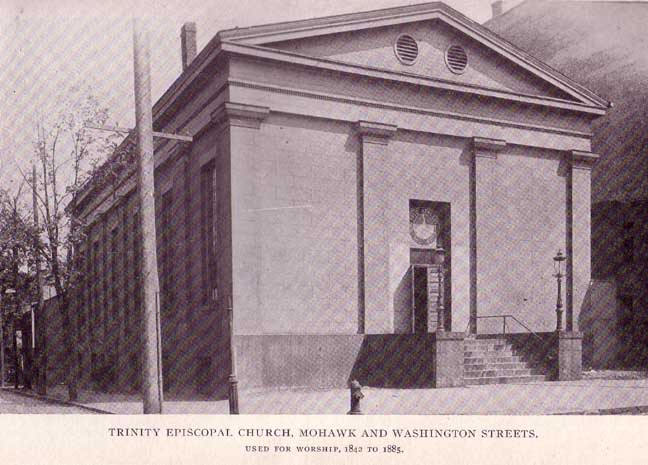Church
of the Good Shepherd - Table
of Contents .............
James Napora, Houses of
Worship - Table of Contents
History of Church of
the Good
Shepherd
96
Jewett Pkwy. at Summit, Buffalo, NY
By James Napora
 Elam R. Jewett Photo source: History of the City of Buffalo and Erie County, H. Perry Smith, editor. Syracuse: D. Mason & Co., 1884, Vol 2, p.328  Willow Lawn Illustration source: Victorian Buffalo, by Cynthia Van Ness  Photo source: The Picture Book of Earlier Buffalo, Frank H. Severance, ed. Buffalo Historical Society Publications, Vol. 16, 1912.  Ingersoll died in 1883  Trinity Episcopalian Church on Mohawk and Washington (Demolished) Photo source: The Picture Book of Earlier Buffalo, Frank H. Severance, ed. Buffalo Historical Society Publications, Vol. 16, 1912, p. 131  William Sydney Wicks House, 124 Jewett Parkway  Darwin D. Martin House, 125 Jewett Parkway |
|
The text below is excerpted from Houses of Worship: A Guide to the Religious Architecture of Buffalo, New York By James Napora Master of Architecture thesis Found at Buffalo Central Library NA5235 B8 N37 1995 Houses of Worship: A Guide - Table of Contents Having the distinction of being the only house of worship financed by one single individual, the Church of the Good Shepherd stands as a monument to the friendship of two people. In the early 1880s, the area where the church now stands belonged to the estate of Elam R. Jewett. Known as Willow Lawn, the estate was named for the two yellow willows that stood at its northern entrance. Mr. and Mrs. Jewett were steadfast members of Trinity Episcopal Church and through their relationship with the church, Elam as a vestryman, they developed a warm and genuine friendship with its pastor, Rev. Edward Ingersoll. Consequently, his death on 6 February, 1883 had a great effect upon the Jewetts. With his passing, friends and associates of Rev. Ingersoll desired to build a suitable memorial to a man that had touched their lives in so many ways. In August, 1883 Jewett approached the Episcopal Church Charity Foundation offering a substantial donation to this cause. As they failed to reached agreeable terms regarding the conditions of the donation, he withdrew his offer, opting instead to construct his own church as a memorial to his friend. Jewett became engrossed in this endeavor. He desired to have a fitting memorial reflective of the character of Rev. Ingersoll. He put much thought into what form the building should take. Through his work at Trinity, he became familiar with the ideologies of the burgeoning Arts and Crafts Movement. Respectful of the approach of the followers of the movement, Jewett desired a memorial free of the excess of Victorian design. He requested the firm of Silsbee and Marling to provide him with a suitable design. As construction of the building neared, Silsbee ended his partnership with Marling. Herbert Burdett replaced him (Marling & Burdett) and in 1888 assisted Marling on reworking the original design. Jewett did not live to see work begin on the building as he died on 10 January, 1887. On 31 May, 1887, Bishop Arthur Cleveland Coxe placed the cornerstone of the church. The first services were held in the building on 4 March, 1888 and it was formally dedicated on 21 May. The neighborhood, at the time of the building's completion, retained its rural character. Outside of the Jewett home across the street from the church, there were very few other buildings to be seen. The first pastor, Rev. Thomas Berry, referred to the area as the "Buffalo Plains," a reflection of its desolate appearance. But soon after, the church acted as a catalyst for development of the neighborhood and homes began to be built on the streets adjoining the church property. In 1890, the architect William Sydney Wicks constructed his home at 124 Jewett and thirteen years later, Frank Lloyd Wright began designing the Martin House across the street. See also: Highlights of Buffalo History, 1888 Guild house The increase of members resulted in a need for additional space. In 1891, the members constructed the guild house as a memorial to Elam Jewett. Prior to this time, they were forced to meet in homes of members or at Trinity Church downtown. Children's chapel In 1930, Buffalo architects North and Shelgren prepared plans for the conversion of the guild house into a children's chapel. The chapel serves as a memorial to William Phelps Northrup, cousin of Jewett. He is credited with convincing Jewett to build the church in its current location. Highlighting the chapel is a Tiffany window depicting Christ as the Good Shepherd. The children in the window are believed to be portraits of the Northrup children. Church design The church itself is designed in the Richardsonian Romanesque style. Constructed of blue limestone, a stately tower marks the building's entrance. The interior, with its open truss roof, provides a subdued setting for one of the finest collections of Tiffany glass in the city. Nine windows in all, the most noted light portrays Christ as the Good Shepherd. Depicting Christ carrying two lambs, the design is directly attributed to Louis Comfort Tiffany.
|